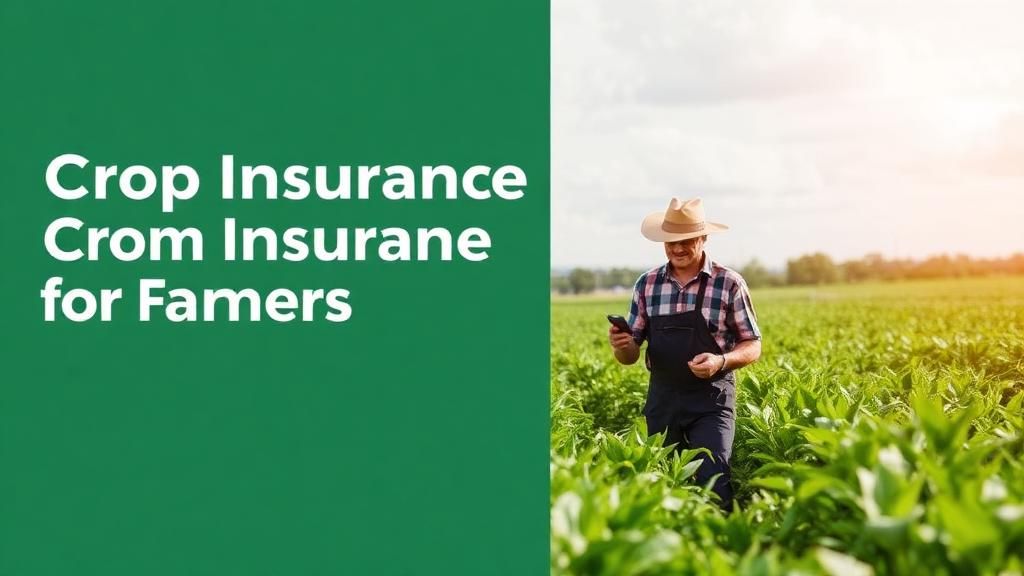Agriculture has always been a business of risk. Weather patterns shift without warning, pests and plant diseases evolve, and market prices can swing overnight. For farmers, these uncertainties translate into a simple truth: a single season’s disaster can erase years of hard work and investment.
That’s where crop insurance comes in. In 2025, with climate change accelerating and global food demand increasing, crop insurance is no longer optional—it’s essential. This guide explores everything farmers need to know about crop insurance for 2025, from new policy options to tips for getting the best coverage and price.

What Is Crop Insurance?
Crop insurance is a financial protection tool that compensates farmers when their crops suffer losses due to covered perils such as:
- Natural disasters: drought, flood, hail, frost, hurricane, excessive heat
- Market volatility: sudden drops in commodity prices
- Disease and pests: infestations or plant epidemics
The primary goal is to stabilize farm income, ensure food supply, and help farmers recover quickly after a loss.
Why 2025 Is a Critical Year for Crop Insurance
Several trends make 2025 especially important for farmers considering crop insurance:
- Climate Uncertainty
Unpredictable weather events—droughts in one region, record floods in another—are becoming more frequent.
Insurance providers have updated risk models to reflect this reality. - Rising Input Costs
Seeds, fertilizers, and fuel prices continue to climb. Losing a crop now means far bigger financial pain. - Government Policy Updates
Many countries, including the U.S. and India, have introduced new subsidies and premium-sharing programs in 2025 to encourage more farmers to get insured. - Technology Integration
Satellite imaging, AI-driven weather forecasts, and blockchain-based claim systems are making crop insurance more accurate and faster.
Types of Crop Insurance Available in 2025
Farmers can choose from different types of coverage depending on their crops, region, and risk appetite.
1. Yield-Based Insurance
- Purpose: Protects against lower-than-expected crop yields.
- How it Works: If harvested yield falls below a guaranteed level, the policy pays the difference.
2. Revenue-Based Insurance
- Purpose: Covers both yield loss and price drops.
- How it Works: If your revenue (yield × market price) is lower than the guaranteed amount, you receive a payout.
3. Weather Index Insurance
- Purpose: Offers quick payouts based on measurable weather conditions (rainfall, temperature).
- How it Works: No need for field inspections—if rainfall is below a set threshold, payment is triggered automatically.
4. Area-Based Insurance
- Purpose: Coverage based on average yields or losses in a geographic area.
- How it Works: If the entire region suffers losses, all insured farmers in that region are compensated.
5. Specialized or Named-Peril Policies
- Purpose: Protection against specific risks like hail or frost.
- How it Works: Farmers choose the perils they want to insure against.

Key Factors That Affect Crop Insurance Premiums
When you request a crop insurance quote for 2025, insurers consider:
- Crop Type – High-value or high-risk crops (like specialty vegetables or fruits) cost more to insure.
- Location & Climate – Areas prone to drought, flooding, or storms carry higher premiums.
- Historical Yield Data – A strong yield history can reduce your rate.
- Coverage Level & Deductibles – Higher guaranteed yields or lower deductibles increase premiums.
- Farm Practices – Sustainable farming, irrigation systems, and risk-mitigation practices may qualify for discounts.
Average Costs in 2025
Premiums vary widely, but here are ballpark figures (per acre, U.S. averages):
| Crop Type | Typical Coverage | Avg. Premium (USD) |
|---|---|---|
| Corn | 70–75% yield | $18 – $28/acre |
| Soybeans | 70–75% yield | $15 – $22/acre |
| Wheat | 65–70% yield | $10 – $18/acre |
| Specialty Crops | Custom coverage | $25 – $60+/acre |
Government subsidies can cover 30–60% of the premium, depending on location and policy type.
How to Get a Crop Insurance Quote in 2025
Step 1: Gather Farm Data
- Acres planted, historical yields, crop rotation plans
- Irrigation and pest-control methods
- Past insurance or claims history
Step 2: Decide on Coverage
- Determine if you need yield-based, revenue-based, or weather-index coverage.
- Set your desired coverage level (commonly 70–85% of historical yield or revenue).
Step 3: Compare Providers
- Leading U.S. providers: Rain and Hail, RCIS, NAU Country, ProAg
- India: Pradhan Mantri Fasal Bima Yojana (PMFBY) approved insurers
- Global: Swiss Re, Allianz, Munich Re for reinsurance-backed policies
Step 4: Review the Fine Print
- Understand exclusions (e.g., damage due to negligence)
- Check claim filing deadlines and documentation requirements.
Tips to Reduce Your Premium
- Adopt Risk-Reducing Practices: Drip irrigation, soil conservation, and pest monitoring can earn discounts.
- Bundle Policies: Combine crop insurance with farm property or equipment insurance.
- Use Technology: Weather stations and satellite data prove your risk mitigation efforts.
- Pay Annually: Annual payments sometimes cost less than monthly installments.
Role of Technology in 2025
Modern crop insurance relies heavily on precision agriculture tools:
- Satellite & Drone Monitoring: Quick, unbiased assessment of damage.
- Blockchain Claims Processing: Transparent and faster payouts.
- AI Weather Prediction: Better premium calculations and risk modeling.
These tools not only streamline claims but also help farmers adopt smarter risk-management practices.
Government Support and Subsidies
United States
The USDA’s Risk Management Agency (RMA) continues to provide subsidies covering a significant portion of premiums, making insurance more affordable for small and large farms alike.
India
The Pradhan Mantri Fasal Bima Yojana (PMFBY) offers premium caps and direct benefit transfers to farmers, ensuring quick payouts during disasters.
Europe & Other Regions
Many EU countries are expanding climate-risk insurance funds, while developing nations are partnering with global reinsurers to introduce index-based products.

Real-World Example: How Insurance Saved a Farm
Case Study:
A Midwest corn farmer experienced a devastating drought in 2024. With revenue-based insurance at 80% coverage:
- Expected revenue: $600/acre
- Actual revenue: $300/acre
- Payout: ($600 × 0.8) – $300 = $180/acre
This payment allowed the farmer to cover input costs and replant for 2025 without taking on crushing debt.
Frequently Asked Questions
Q: Is crop insurance mandatory?
In most countries, no—but lenders often require proof of insurance for farm loans.
Q: Can I insure multiple crops under one policy?
Yes, multi-peril policies allow you to cover several crops at once.
Q: When should I buy crop insurance?
Purchase before planting or within the specific sales closing date set by your country or region.
Q: How quickly are claims paid?
With 2025’s tech upgrades, many weather-index policies pay within 2–4 weeks of a verified event.
Key Takeaways
- Crop insurance is essential in 2025 due to climate volatility, rising costs, and evolving global markets.
- Farmers can choose from yield-based, revenue-based, weather-index, or specialty policies to match their risk profile.
- Government subsidies, technological innovations, and competitive providers make coverage more accessible than ever.
Final Thoughts
Farming will always involve risk—but in 2025, farmers don’t have to shoulder that risk alone.
By understanding the types of crop insurance available, comparing multiple quotes, and leveraging government programs, you can safeguard your livelihood and plan for long-term growth.
Whether you cultivate hundreds of acres of corn in the Midwest or grow specialty produce on a small organic farm, crop insurance is the smartest investment you can make this year.
crop insurance 2025, gujarat farmers crop insurance, crop insurance scheme 2025, crop insurance scheme 2025 kharif, crop insurance reform, crop insurance, crop insurance scheme, farmers insurance gujarat, crop insurance tamil, haryana crop insurance scheme, crop insurance subsidy, government crop insurance company, how to claim crop insurance, crop insurance issue india, financial planning for farmers, pmfby crop insurance status check, how to apply crop insurance in tamil, farmer’s mutual hail insurance




